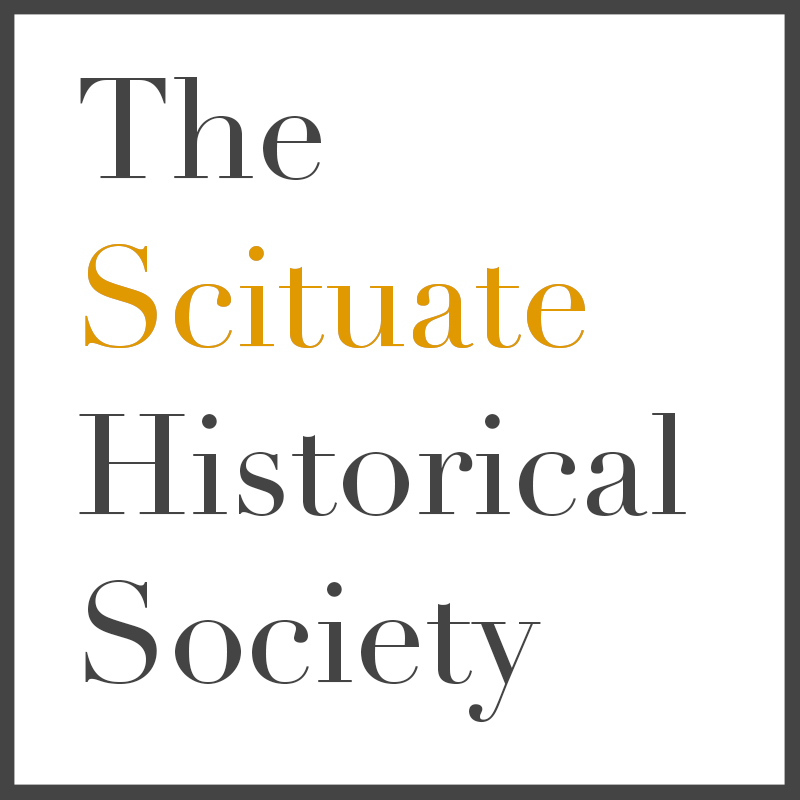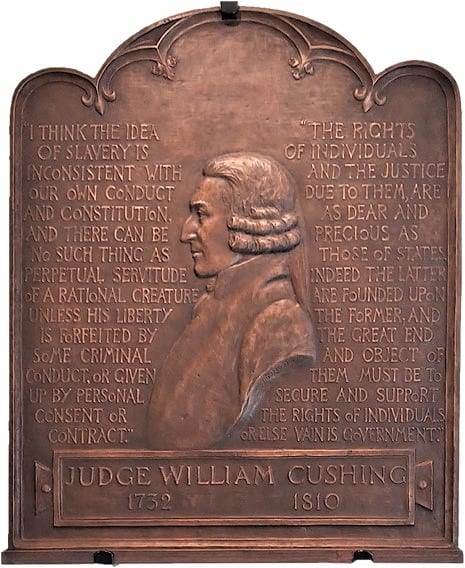COLLECTION HIGHLIGHT
Cyrus E. Dallin
Chief Justice William Cushing Memorial Tablet 1919
Commissioned by Scituate Historical Society
Cast Bronze
Dims: H 44 ½” x W 36 ¾” x D ¾ “
The Scituate Historical Society commissioned this cast bronze memorial plaque by sculptor Cyrus Dallin to honor Chief Justice William Cushing. The tablet was installed with a formal dedication ceremony at the junction of Stockbridge Road and Chief Justice Cushing Highway (3A) on August 30, 1919, which was declared William Cushing Day. The tablet depicts a relief profile bust of Chief Justice William Cushing, surrounded by Cushing’s text written in relation to the Massachusetts Supreme Court case of the Commonwealth of Massachusetts v. Nathaniel Jennison. The case, over which Chief Justice Cushing presided, determined that former slave Quock Walker was a free man. The ruling was pivotal in ending slavery in Massachusetts. The aesthetic quality of the plaque’s text is distinguished by Dallin’s hand-carved lettering, which integrates Cushing’s words fully into the design of the relief.
Born in Scituate in in 1732, Chief Justice William Cushing was one of the five original justices of the United States Supreme Court. William Cushing was the son of magistrate John Cushing and Mary Cotton Cushing, a descendant of the Puritan theologian John Cotton. He was raised in Scituate at Belle House Neck, a property purchased by his ancestor John Cushing in 1652. William Cushing graduated from Harvard College in 1751 and practiced law until 1772 when he was appointed to the Massachusetts Superior Court by Governor Thomas Hutchinson. In 1777, he became the Chief Justice of the Massachusetts Supreme Court. President George Washington appointed Cushing to the Supreme Court of the United States on September 24, 1789, shortly after its formation. Although Cushing was nominated and confirmed as Chief Justice of the Supreme Court, he declined the appointment, and continued to serve as an Associate Justice until his death in 1810. See Black and White Justice for more information on freedom suits under Additional Information below.
Sculptor Cyrus Dallin was born in Springville, Utah in 1861. At age nineteen, he traveled to Boston to study with sculptor Truman H. Bartlett. He went on to study in Europe for several years before returning to Massachusetts. Around 1900 he settled in Arlington with his wife and children and joined the faculty of the Massachusetts Normal Art School (now Massachusetts College of Art and Design) where he would teach for 40 years. Dallin’s work was commissioned for numerous public statues and memorials, including his equestrian statue of Paul Revere in Boston’s North End, and his Appeal to the Great Spirit at the Museum of Fine Arts, Boston. Having formed lifelong friendships with the Ute people who lived near his boyhood home, he was a passionate advocate for the rights of indigenous peoples, and is known, in particular, for his sculptural tributes to America’s native peoples.
In 2012, the town of Scituate generously granted Community Preservation Act funds for the conservation and preservation of the Chief Justice William Cushing Memorial tablet by Skylight Studios. A mold was taken of the original tablet from which a resin reproduction was cast. The original Cyrus Dallin tablet was moved to The Schoolhouse, where it can be viewed. The resin reproduction tablet was installed on the original stone marker, which was then moved to a location nearby the Stockbridge Grist Mill on Stockbridge Road for greater visibility.
Curriculum Connections
This Scituate Historical Society Collections Highlight connects with the following Massachusetts State Curriculum Frameworks:
3.T5, 4. Explain that in the 17th and 18th century slavery was legal in all the French, Dutch, and Spanish, and English colonies, including Massachusetts and that colonial Massachusetts had both free and enslaved Africans in its population.
5.T1, 5. Describe the origins of slavery, its legal status in all the colonies through the 18th century, and the prevalence of slave ownership, including by many of the country’s early leaders (e.g., George Washington, Thomas Jefferson, James Madison, George Mason.) 7. Compare and contrast the living and working conditions of enslaved and free Africans in the colonies in the 18th century, and explain how some enslaved people sought their freedom., d. States in the North adopted gradual emancipation (for example, Massachusetts outlawed slavery in 1783 and no enslaved people appear in the 1790 Massachusetts census); free African Americans could have families, own property, hold jobs, and earn a living.
8.T3, 1. Distinguish the three branches of government (separation of powers). 2. Examine the interrelationship of the three branches (the checks and balance system).

